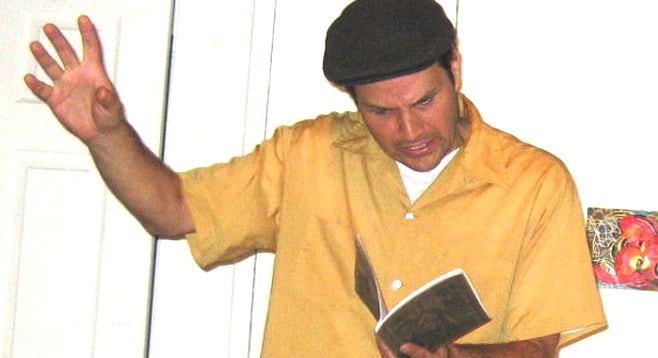 Facebook
Facebook
 X
X
 Instagram
Instagram
 TikTok
TikTok
 Youtube
Youtube

Spoken-word performer and novelist Jimmy Jazz got his pseudonym from the Clash song of that name. He grew up in Ocean Beach and Mira Mesa, which he describes as “a prison” in his novel The Sub.
“Mira Mesa is a trap. I think a lot of young people longed for something to do and found only drugs or TV; smoking the opium hookah, the TV IV.”
Jazz paints a brighter picture of San Diego’s music scene in the ’90s, especially around seeing the Cadillac Tramps.
“I thought they were the greatest band of all time. People here went crazy for them.... There was a galvanic feeling in the air every time you went out in the ’90s. But when we got to Phoenix, they were the opening band for some lame group. They gave an amazing performance, but no one cared.”
Jazz found several ways to merge music with his passion for words in the ’90s.
“I always wanted to be the fifth Creedle. There were a lot of fifth Creedles, such as Rob Crow, and another guy who did bird calls. They were always pulling people up onstage. Creedle had a quiet instrumental interlude. I would stand up and say something like, ‘How many people out there have read a book? One...two...three. How many people have read a book by Charles Bukowski? One, two, three, seven...20. More people have read books by Bukowski than have read books.’ Then I’d take off into my poem. It’s exhilarating being up there — doing it instead of watching it.”
Jazz will be up there again at the San Diego Art Institute, reading from the new edition of his 1993 novel Cadillac Tramps.
“It’s set in the early ’90s music scene. The characters make the scene at local clubs, like the now-defunct Megalopolis and the old Casbah. It’s an updating of Jack Kerouac’s On the Road for a new generation — de-mythologizing the genre, taking the cool out of it by having three dorks rent a Plymouth Acclaim and drive from San Diego to Phoenix and back to see their favorite band. I consider it a tragedy. Instead of finding enlightenment in the desert, the characters resume a banal, bourgeois life, symbolized by renting a video.”
Jazz will be joined by musician Nathan Hubbard on March 1 at the San Diego Art Institute in Balboa Park.


Spoken-word performer and novelist Jimmy Jazz got his pseudonym from the Clash song of that name. He grew up in Ocean Beach and Mira Mesa, which he describes as “a prison” in his novel The Sub.
“Mira Mesa is a trap. I think a lot of young people longed for something to do and found only drugs or TV; smoking the opium hookah, the TV IV.”
Jazz paints a brighter picture of San Diego’s music scene in the ’90s, especially around seeing the Cadillac Tramps.
“I thought they were the greatest band of all time. People here went crazy for them.... There was a galvanic feeling in the air every time you went out in the ’90s. But when we got to Phoenix, they were the opening band for some lame group. They gave an amazing performance, but no one cared.”
Jazz found several ways to merge music with his passion for words in the ’90s.
“I always wanted to be the fifth Creedle. There were a lot of fifth Creedles, such as Rob Crow, and another guy who did bird calls. They were always pulling people up onstage. Creedle had a quiet instrumental interlude. I would stand up and say something like, ‘How many people out there have read a book? One...two...three. How many people have read a book by Charles Bukowski? One, two, three, seven...20. More people have read books by Bukowski than have read books.’ Then I’d take off into my poem. It’s exhilarating being up there — doing it instead of watching it.”
Jazz will be up there again at the San Diego Art Institute, reading from the new edition of his 1993 novel Cadillac Tramps.
“It’s set in the early ’90s music scene. The characters make the scene at local clubs, like the now-defunct Megalopolis and the old Casbah. It’s an updating of Jack Kerouac’s On the Road for a new generation — de-mythologizing the genre, taking the cool out of it by having three dorks rent a Plymouth Acclaim and drive from San Diego to Phoenix and back to see their favorite band. I consider it a tragedy. Instead of finding enlightenment in the desert, the characters resume a banal, bourgeois life, symbolized by renting a video.”
Jazz will be joined by musician Nathan Hubbard on March 1 at the San Diego Art Institute in Balboa Park.
Comments